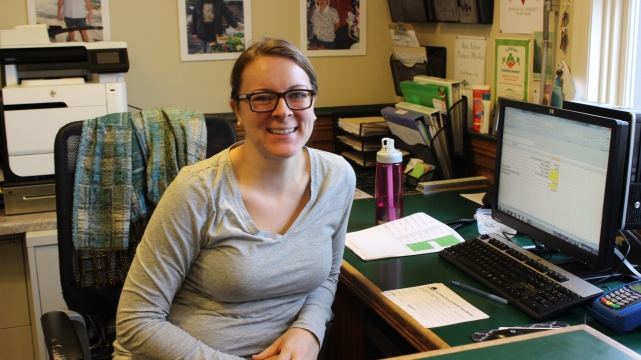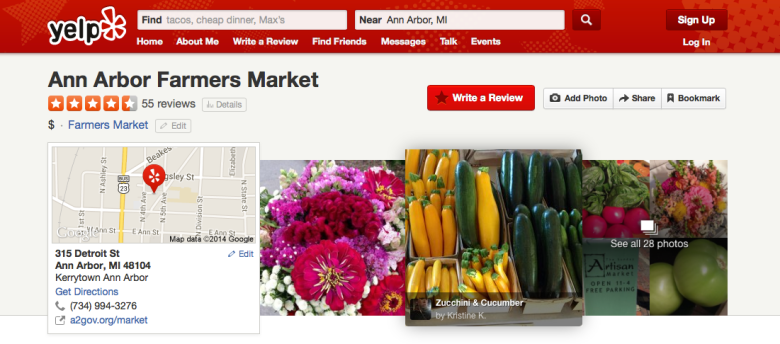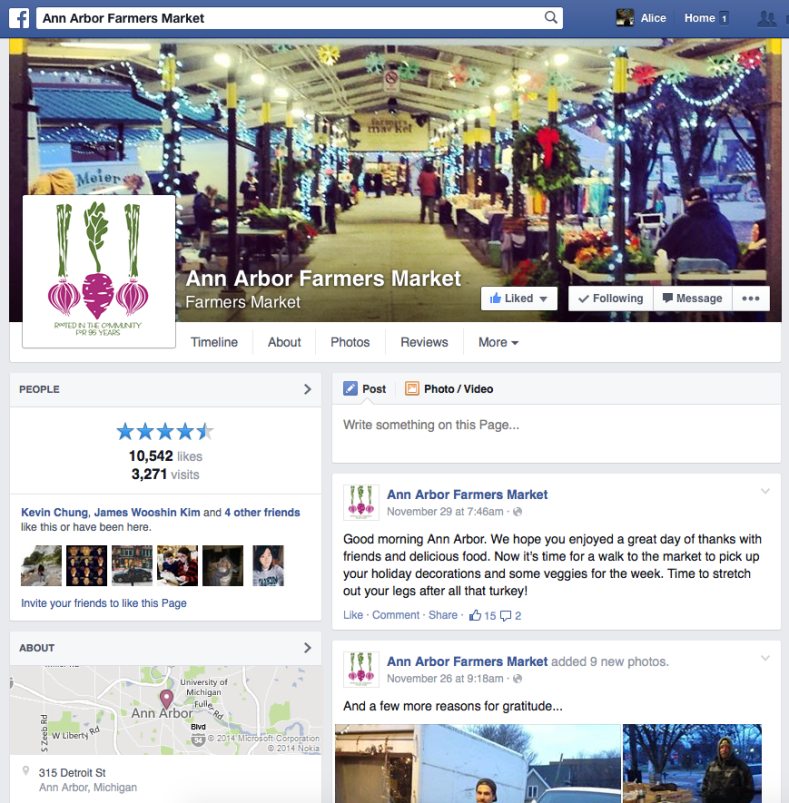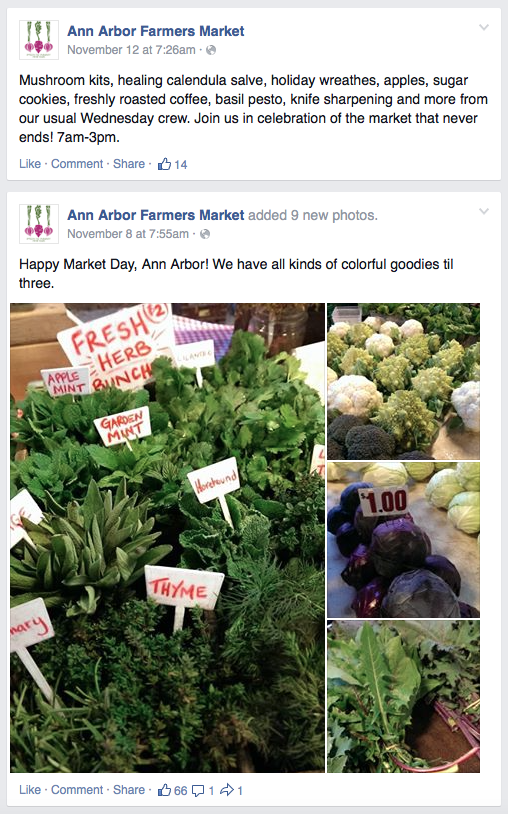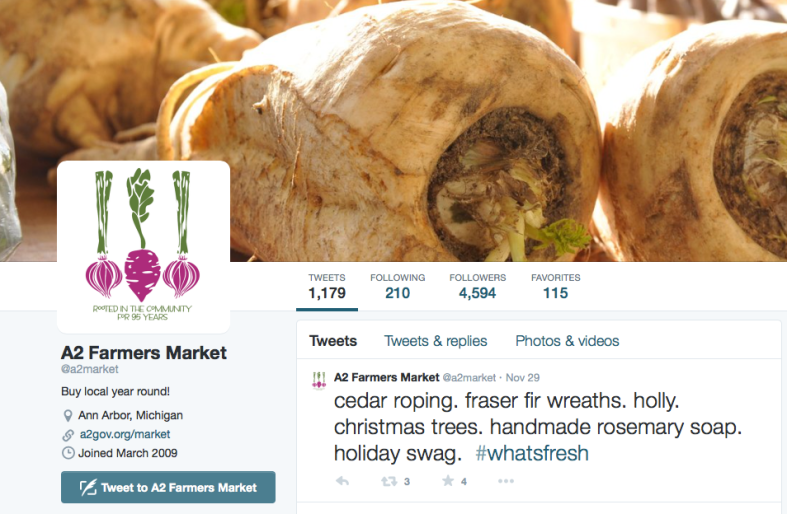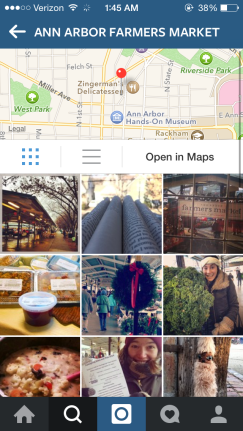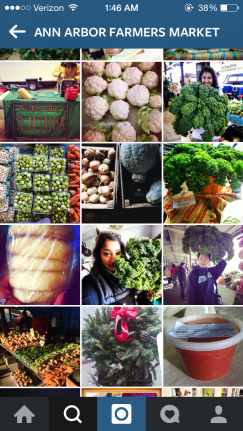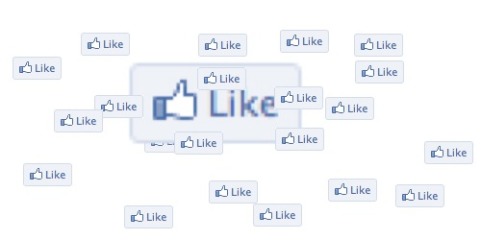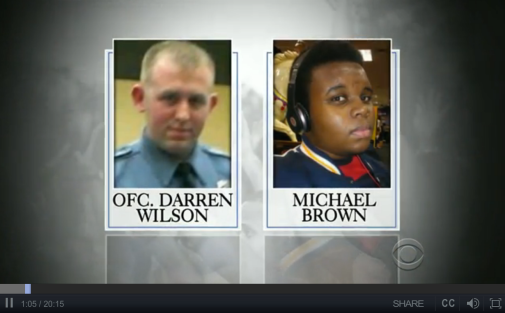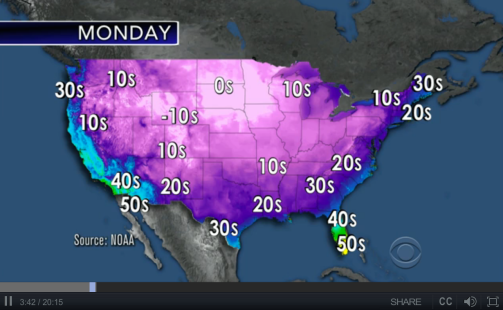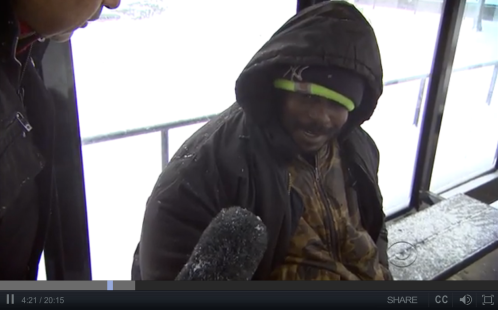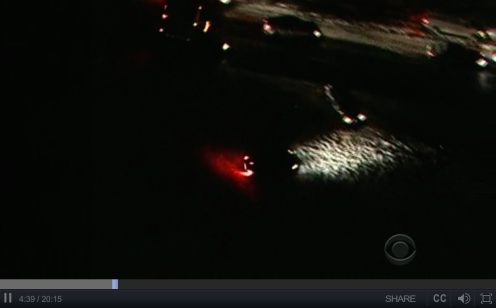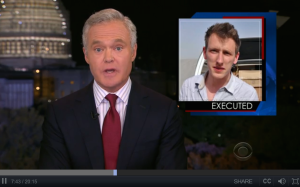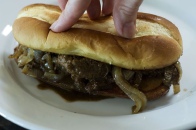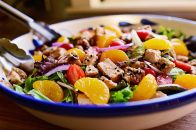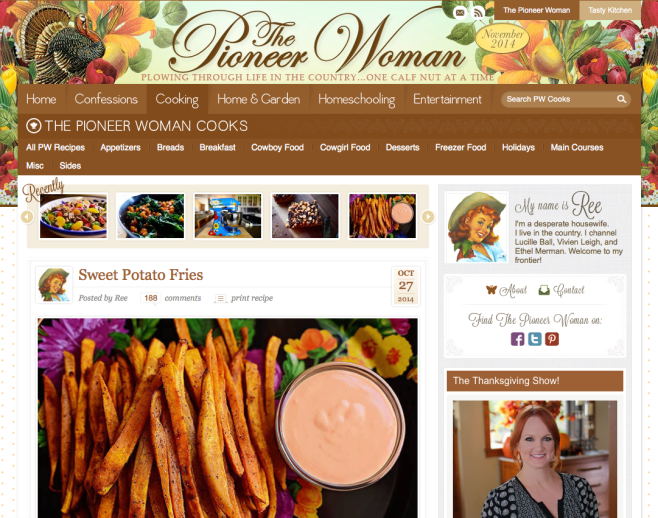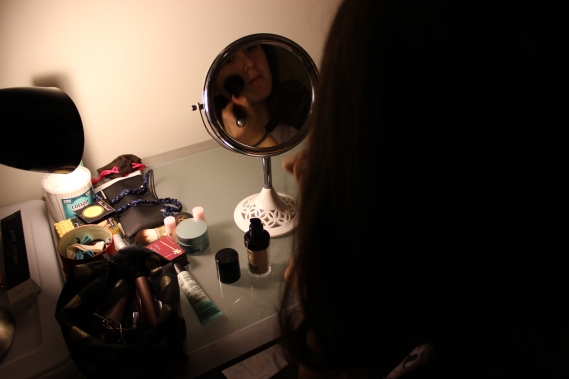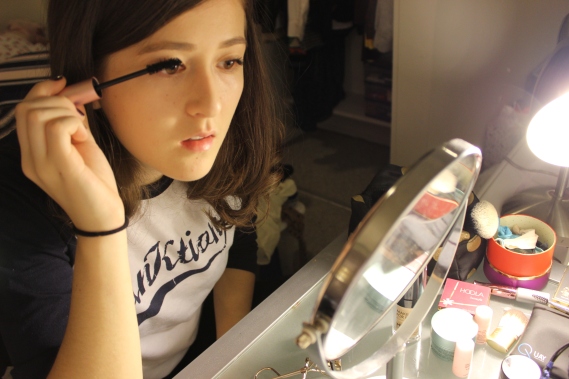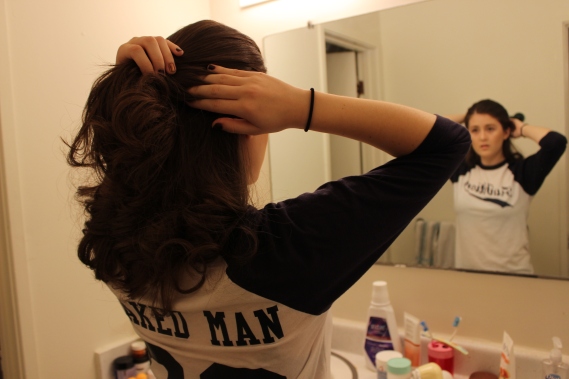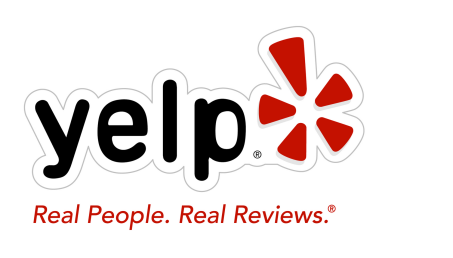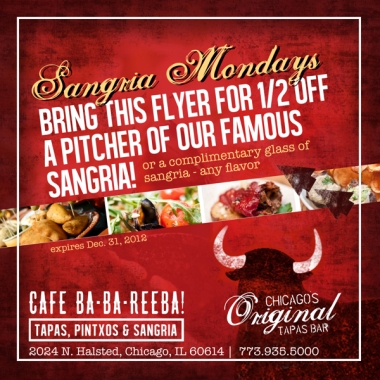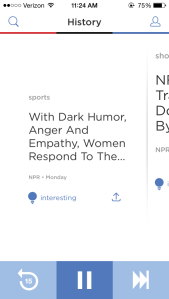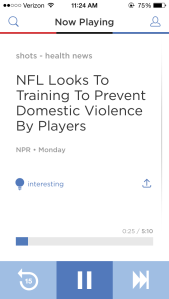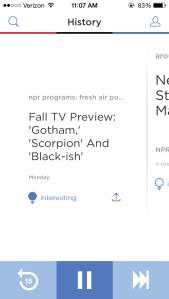Throughout my time here at Ann Arbor, I had heard about the Farmers Market several times but for some reason never gone myself. It was an intriguing concept to me: How could a Farmers Market survive in an age where everything is mass produced and industrialized in order to be more cost efficient and convenient? I very stereotypically assumed that only health nuts or hipsters who wanted to take cool Instagram photos shopped at the Farmers Market. But when I went for the first time, I was pleasantly surprised to see all sorts of people including families, students, and several people shopping solo. Another shocking aspect was how inexpensive a lot of the produce was. Since everything is grown local, I thought that the prices would be higher, but my roommate bought an onion for just $0.75!
I had seen adverts for the Ann Arbor Farmers Market online and so I was curious to know how they ran their social media system. In order to discover more on this topic, I spoke with Sarah Dewitt the Market Manager. Listen to the interview below, or view the written transcript:
AC: Hi this is Alice Choi, and today we’re joined by Sarah Dewitt, the market manager at the Ann Arbor Famers Market. Welcome Sarah!
SD: Thank you for having me.
AC: If I could ask you some questions that would be great.
SD: Sure.
AC: How has social media affected the market?
SD: So we’ve actually seen a really great use of social media with the market. We post updates about what’s available at the market on any given market day on Twitter, so we talk about what’s fresh, and we highlight about ten items per market day that gets a lot of attention. And then we also post on Facebook on market days and answer questions for customers about hours or who’s there and things like that, so it’s nice to be able to give a visual to people. In the time that I’ve been here in the last 2.5 years, we’ve grown our Facebook population from 3,000 to 11,000 followers.
AC: That’s really cool, I noticed when I went online I was really impressed.
SD: Yeah we have a good following!
AC: Do you think you can give me an example of a marketing strategy used involving a new technology?
SD: Sure, so this year actually we used our Instagram account and had a Wednesday evening market intern do short videos on Instagram featuring our Wednesday evening market vendors- just little snippets to get people interested in what is our newest market time. So that market is only 4 years old so we’ve used social media a lot to get people interested in new vendors and people they haven’t necessarily seen elsewhere. Again we had a really big uptake; we had about 50 followers previously now we have over 400, might even be 600 at this point. (731 Instagram followers as of date!)
AC: Wow, that’s really impressive especially since you guys have just started it too. Can you tell me about your market tokens? Has this resulted in a noticeable increase in sales?
SD: Sure, so we do credit card tokens for people who don’t have cash with them at the market, with a $20 minimum because we don’t charge any administration fee. The tokens work like five dollar bills so they work like cash so if you don’t spend the whole five dollars you get cash change. They don’t expire; you can use them on any market day. Almost all the vendors here choose to participate, it is an option for them; basically they work in lieu of cash in the market so it’s just a nice way in case you didn’t get to the ATM in the morning to make sure you can still shop. We have secured over $100,000 in credit card token purchases this year, but it doesn’t necessarily mean we have $100,000 more in sales because we don’t know how much of that was in cash previously, so its hard to measure the growth. But it is $100,000 of money that’s supposed to be focused in the market so it’s really excellent.
SD: The second piece of the token program are that we process SNAP benefits in our office so that’s federal food assistance dollars. SNAP stands for supplemental nutrition assistance program so anybody using federal food assistance can come to the market and also get tokens. They’re different than our credit card tokens; they are limited to food products only. You could also buy vegetables and fruit starter plans as well to take home, so that gives people a nice option if you know they’re on a tight budget and they have a Bridge card which is the Michigan version of the federal food assistance card to be able to spend that money at the farmers market otherwise they would not be able to do so. We also participate in a grant incentive program along with those tokens that allows people using their food assistance to double that amount of money up to $20 for market day, so if you spend $20 off your card we give you $40. The extra $20 is just for fruits and vegetables and that program currently runs June through the end of October so it really stretches people’s food dollars which is really awesome, and we’re happy to participate
AC: Yeah for sure sounds amazing! What do you see happening for the market as technology continues to advance?
SD: That’s a great question. So technologically speaking, we will probably move away from these token programs in the next 5 years and that will be because the WIC program, which is women infants and children at a federal level, has a mandate that by 2020 everything will be electronically transferred. So a program that we currently offer includes vouchers through the WIC office, and some markets process WIC dollars off of what looks very similar to a federal food assistance card for WIC participants. Those will all have to move to electronic so probably what will happen is at the same time they will move federal food assistance dollars to electronic system as well so what that will mean for vendors—and there’s already a pilot going on in Kent county in the Grand Rapids area right now for that program—so what will happen and what’s happening in that pilot is that vendors have been given, through the pilot, i-devices, so iPhones, iPads, iPods, and they have apps on there to process credit card tokens, food assistance benefits, WIC benefits, double up tokens, which is the grant incentive program. So there’s a whole host of things going on to transfer that stuff to electronic systems that will be quite a change of pace and vendors here will eventually have to invest in their own device to participate in this program but because tokens and federal food assistance are such a major source of revenue, there’s going to be a lot of incentive for them to participate. Basically technology will push us out of what is very old school tokens and allow us to move towards digital systems in that way
AC: How do you plan to keep up with an increasingly mass produced and artificial market?
SD: By staying true to our mission, which is that we’re a producers only farmers market so we only accept vendors who grow, make, raise the food themselves or make the artisan products themselves. So by staying true to that mission, you know we’re supporting businesses that are not moving in those directions and helping our community to have a central place to access those kinds of goods that aren’t moving in that direction. So by staying true to our mission and also by making sure that our mission is well known, those are two really good ways for us to stay ahead of that game and offering what is a completely alternative product to a lot of what is out there.
AC: Wow that sounds great, thank you so much for your time!
SD: Sure thank you for having me!
(Reach Sarah at SDeWitt@a2gov.org)
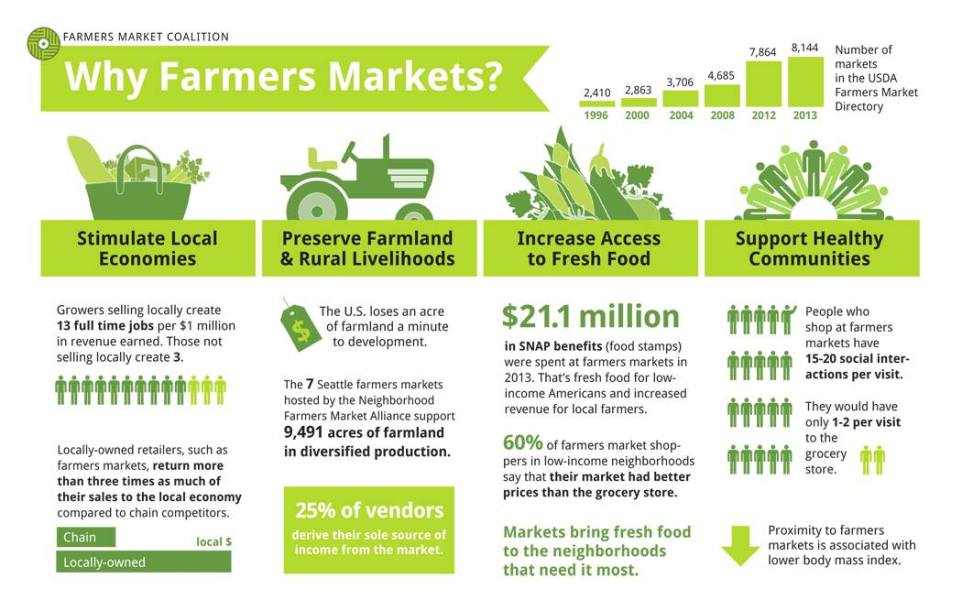 This infographic was interesting to me because it’s aesthetically pleasing at first glance, and then highly informative upon further inspection. I thought it was smart to show how Farmers Markets can be beneficial to both sides (consumers and vendors), because who doesn’t want to participate in a win-win situation? Also, I thought that the social interactions was a very accurate point, because it’s completely true that when i go to a grocery store I interact with max 1-2 people- sometimes not even that since the invention of the self-checkout lane. Whereas, when I went to the Farmers Market, I talked to all of the vendors because I was curious about their produce and products. They were all friendly and happy to share their expertise because they’ve personally created that product while grocery store workers are just waiting for their lunch break. Furthermore, I was pleased to see the SNAP benefits included in this infographic, because I had learned about the program through my interview with Sarah. It was eye-opening to learn exactly how much these food stamps help people in shopping at Farmers Markets. And lastly, I was surprised to see the extreme increase since 1996 to 2013 in the number of Farmers Markets, since I had previously thought that it was a dying field.
This infographic was interesting to me because it’s aesthetically pleasing at first glance, and then highly informative upon further inspection. I thought it was smart to show how Farmers Markets can be beneficial to both sides (consumers and vendors), because who doesn’t want to participate in a win-win situation? Also, I thought that the social interactions was a very accurate point, because it’s completely true that when i go to a grocery store I interact with max 1-2 people- sometimes not even that since the invention of the self-checkout lane. Whereas, when I went to the Farmers Market, I talked to all of the vendors because I was curious about their produce and products. They were all friendly and happy to share their expertise because they’ve personally created that product while grocery store workers are just waiting for their lunch break. Furthermore, I was pleased to see the SNAP benefits included in this infographic, because I had learned about the program through my interview with Sarah. It was eye-opening to learn exactly how much these food stamps help people in shopping at Farmers Markets. And lastly, I was surprised to see the extreme increase since 1996 to 2013 in the number of Farmers Markets, since I had previously thought that it was a dying field.
Even though the Ann Arbor Farmers Market had their own Instagram page, I was also interested in customers’ pictures of the Market on their own Instagram pages. If you click on the location, you are able to see all the pictures that people have uploaded and chose the Market as the location. This works out well for consumers in that they are able to see what’s currently at the Market, and since the pictures are uploaded by other consumers, there is more credibility without a hidden advertising agenda.
Overall, I really enjoyed this project because I was able to experience what it’s like to shop at a Farmers Market firsthand. Even though it was a cold day, the customers and vendors all exuded happiness and cheer especially with the holidays coming up. Even though the old-fashioned idea of a Farmers Market seems like it would be completely separate from technology, the Ann Arbor Farmers Market proves that idea wrong. Sarah told me prior to our interview that the Market has been running for over 95 years. That’s practically a century this Market has been around, and it’s still evolving. Even over the past several years, the Market has utilized social media very effectively and garnered a large faithful, following audience. The Ann Arbor Farmers Market will continue to adapt with newer technologies while never losing the character that makes it unique: simple transactions directly between the consumer and producer.
